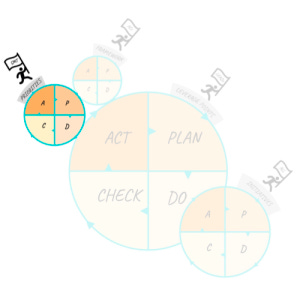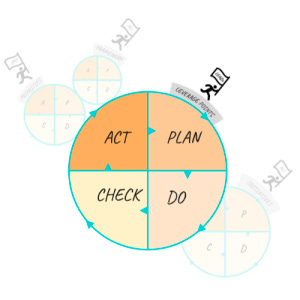FLIP a Scaled framework for organisational development
Improve your company with this framework that allows you to work on internal topics throughout the organisation.
There are many frameworks that try to scale how companies create products. Examples of this are LeSS, Nexus, SAFe, etc. and those are great frameworks for many companies from many different environments.
We found ourselves in the position of needing something different, a process or a framework that is focused on improving the system in whatever way the company is working. Any of the previously mentioned frameworks could work, but we needed something lightweight that could be applied on top of the structure that already exists.
So we came up with this organisational development framework called FLIP (Framework, Leverage points, Initiatives and Priorities). So with this framework you can flip the situation around and improve your company 😉.
Context
The starting point was a thorough analysis we (the Agile Coaches) made interviewing dozens of people in the organisation. We asked multiple questions to uncover what were the core problems the organisation had to solve.
In that way we had the first “leverage points” as we called them to start moving the framework and gathering people together.
Framework Overview
The goal of the framework is to provide guidance and make sure the organisation is focusing on the most important organisational challenges and opportunities.
The framework is composed of different levels of P-D-C-A cycles. That means that in each cycle it is expected that there is a phase for:
Planning (P): Selecting the Items that are priority to be worked on.
executing or Doing (D): Executing on the priority items.
reviewing or Checking (C): Checking the impact that those executions brought.
Acting (A): Acting upon the results by creating new items to work, continue working on them or discontinuing the work.
Those cycles are happening in 4 different artifacts: Priorities, Framework, Leverage Points, Initiatives. Let’s explore each of them individually.
Priorities
Based on the discoveries of the Organisational Research done by the Agile Coaches and based on the proposal for the so-called top-tier list of leverage points made by the Agile Coaches, the SMT agrees on the top Leverage Points that should be explored and addressed in the next step. As the organisation evolves over time and through working on the leverage points, organisational research must be repeated regularly thus also priorities for top leverage points must be re-assessed from time to time.
Accountable & Responsible: SMT (C-levels)
Activities expected:
Understand the system
Set & communicate a priority for a period of time
Set a vision for company topics
Give guidance to the people involved in the different Leverage Points
Plan the priority based on the insights of the Roadshow (or further organisational research over time) and the last period of cadence.
Check what is the progress on the priorities
Decide to drop, create or update a Leverage Point
Cadence: Quarterly (potentially)
Leverage Points
Topics and challenges identified as high impact topics. It means that changing something in that area could potentially cause a bigger change in the organisation. The topics identified as Leverage points are highly interconnected with other challenges and Leverage Points.
Accountable & Responsible: Leads throughout the organisation. Responsibilities can be delegated within the team/ working group
Activities expected:
Organise a team / working group to address a leverage point
Give guidance and a vision to the team if necessary
Identify potential initiatives for the leverage point
Prioritise those initiatives
Inspect the leverage point and identify ways to measure the progress to solving it
Measure how the initiatives are impacting the Leverage Point and what is the progress towards a vision
Make sure that there's progress on the Leverage Point
Discard initiatives and create new ones based on the findings
Assess and make a proposal if the Leverage Point is ready to be "closed"
Cadence: Biweekly (potentially)
Initiatives
Experiments or tasks that try to provoke a change on the Leverage Points. Initiatives are attempts to solve the Leverage Points while keeping the focus on achievable and reachable commitments. It is important to document the learnings and insights.
Accountable & Responsible: Anyone can be Accountable. Responsibilities can be delegated within the team/ working group.
Activities expected:
Organise a team and agree which initiative to tackle within the leverage point
Breakdown the initiative to achievable tasks and experiments
Identify ways to measure the progress on the initiatives
Work on the initiatives and tasks proposed
Make sure that there's work in progress on the Initiative
Iterate on the initiative and check if it's done and if there's any learning to share with the people Leverage Point
Inform the Accountable of the leverage point
Document progress of the initiative
Cadence: Weekly (potentially)
Framework
Based on the feedback received from the people in the framework (on the different parts of the framework) , the Agile Coaches inspect how the framework is performing and propose incremental changes and improvements to the framework to suit its purpose.
Accountable & Responsible: Agile Coaches or Change Agents
Activities expected:
Gather feedback over the framework
Brainstorm and implement possible changes that can be applied to the framework and plan them
Check if the improvements and the framework itself are helping the "wheel to keep moving"
Decide to keep the improvements, drop them or create new ones
Give coaching/mentoring to the people involved in the framework
Cadence: Biweekly (potentially)
Leave your comments and thoughts down below 👇










